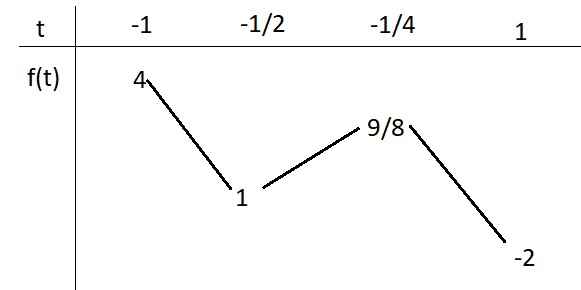1. Hàm số y =2sinx+cos2x , x€ [0;π) đồng biến trên khoảng nào? 2. Hàm số y=|x^2-2x-3| nghịch buến trên khoảng nào?
Hãy nhập câu hỏi của bạn vào đây, nếu là tài khoản VIP, bạn sẽ được ưu tiên trả lời.


Xét hàm số y=2sin x + cos 2x trên đoạn
y’=2cos x- 2sin 2x = 2cos x(1- 2sin x)
Trên đoạn [0; π]

Giá trị lớn nhất của hàm số này trên [0; π] là y = 3 2 .
Chọn B

1. \(D=R\)
2. \(sinx\ne0\Leftrightarrow x\ne k\pi\Rightarrow D=R\backslash\left\{k\pi|k\in R\right\}\)
3. \(cos2x\ne0\Leftrightarrow2x\ne\dfrac{\pi}{2}+k\pi\Leftrightarrow x\ne\dfrac{\pi}{4}+\dfrac{k\pi}{2}\Rightarrow D=R\backslash\left\{\dfrac{\pi}{4}+\dfrac{k\pi}{2}|k\in R\right\}\)
4. \(cos\left(x+\dfrac{\pi}{4}\right)\ne0\Leftrightarrow x+\dfrac{\pi}{4}\ne\dfrac{\pi}{2}+k\pi\Leftrightarrow x\ne\dfrac{\pi}{4}+k\pi\Rightarrow D=R\backslash\left\{\dfrac{\pi}{4}+k\pi|k\in R\right\}\)

\(y=\left|2sin^2x-sinx-1\right|-2sinx\)
Đặt \(sinx=t\in\left[-1;1\right]\)
\(\Rightarrow y=f\left(t\right)=\left|2t^2-t-1\right|-2t\)
BBT cho \(f\left(t\right)\) trên \(\left[-1;1\right]\):

Từ BBT ta thấy \(y_{max}=4\) khi \(sinx=-1\); \(y_{min}=-2\) khi \(sinx=1\)

Đáp án A
Ta có: y = 2 s i nx+cos 2 x
= 2 sin x + 1 − 2 sin 2 x → t → s inx y = f x = − 2 t 2 + 2 t + 1.
Với x ∈ 0 ; π ⇒ t ∈ 0 ; 1 .
Xét hàm số f t = − 2 t 2 + 2 t + 1 trên 0 ; 1 có f ' t = − 4 t + 2.
Ta có: f ' t = 0 ⇔ t = 1 2 .
Tính f 0 = 1 ; f 1 2 = 3 2 ; f 1 = 1.
Vậy M = 3 2 m = 1 ⇒ 2 M + m = 4.

cos2x ≠ 0
⇔ cos 2x ≠ \(\dfrac{\pi}{2}+k\pi\)
⇔ x ≠ \(\dfrac{\pi}{4}+k\dfrac{\pi}{2}\)

1. Không dịch được đề
2.
\(-1\le cos2x\le1\Rightarrow1\le y\le3\)
3.
a. \(-2\le2sinx\le2\Rightarrow-1\le y\le3\)
\(y_{min}=-1\) khi \(sinx=-1\Rightarrow x=-\dfrac{\pi}{2}+k2\pi\)
\(y_{max}=3\) khi \(sinx=1\Rightarrow x=\dfrac{\pi}{2}+k2\pi\)
b.
\(0\le cos^2x\le1\Rightarrow-1\le y\le2\)
\(y_{min}=-1\) khi \(cos^2x=1\Rightarrow x=k\pi\)
\(y_{max}=2\) khi \(cosx=0\Rightarrow x=\dfrac{\pi}{2}+k\pi\)
4.
\(y=\left(tanx-1\right)^2+2\ge2\)
\(y_{min}=2\) khi \(tanx=1\Rightarrow x=\dfrac{\pi}{4}+k\pi\)

Chọn A
![]()
↔ (2-y)sinx + (1+2y)cosx= 3y-1(*)
Sử dụng điều kiện để phương trình (*) có nghiệm suy ra -1/2 ≤ y ≤ 2

a.\(-1\le cosx\le1\Rightarrow-4\le y=3cosx-1\le2\)
b.-1 \(\le sinx\le1\)\(\Rightarrow3\le y=5+2sinx\le7\)
c.\(\sqrt{3-1}\le\sqrt{3+cos2x}\le\sqrt{3+1}\Rightarrow\sqrt{2}\le y\le2\)
d.\(y=\sqrt{5sinx-1}+2\le\sqrt{5.1-1}+2=4\)
\(y=\sqrt{5sinx-1}+2\ge2\) . " = " \(\Leftrightarrow sinx=\dfrac{1}{5}\Leftrightarrow\left[{}\begin{matrix}x=arcsin\left(\dfrac{1}{5}\right)+2k\pi\\x=\pi-arcsin\left(\dfrac{1}{5}\right)+2k\pi\end{matrix}\right.\) ( k thuộc Z )
1.
\(y'=2cosx-2sin2x=2cosx-4sinx.cosx=2cosx\left(1-2sinx\right)\)
\(y'=0\Rightarrow\left[{}\begin{matrix}cosx=0\\sinx=\dfrac{1}{2}\end{matrix}\right.\) \(\Rightarrow\left[{}\begin{matrix}x=\dfrac{\pi}{2}\\x=\dfrac{\pi}{6}\\x=\dfrac{5\pi}{6}\end{matrix}\right.\)
Hàm đồng biến trên các khoảng \(\left(0;\dfrac{\pi}{6}\right)\) và \(\left(\dfrac{\pi}{2};\dfrac{5\pi}{6}\right)\)
2.
Xét hàm \(f\left(x\right)=x^2-2x-3\)
\(f\left(x\right)=0\Rightarrow\left[{}\begin{matrix}x=-1\\x=3\end{matrix}\right.\)
\(f'\left(x\right)=2x-2=0\Rightarrow x=1\)
Hàm nghịch biến trên các khoảng \(\left(-\infty;-1\right)\) và \(\left(1;3\right)\)